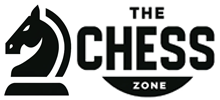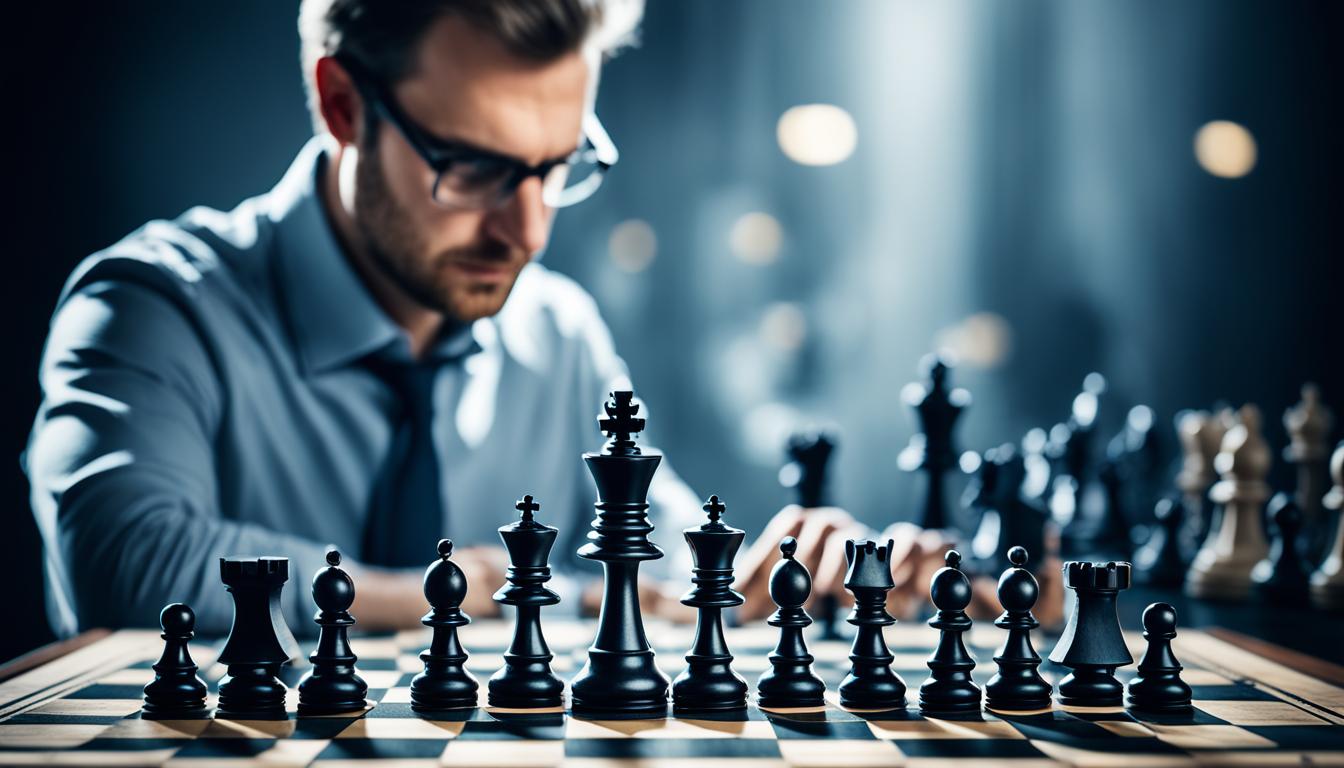Did you know that learning advanced chess tactics is crucial to win? These tactics include sensing moves and judging sacrifices. They help raise your game and give you an edge over others.
To get better at chess, players need to learn complex tactics beyond the basics. These require skill in calculation and strategic thinking. They help beat opponents and win the game.
This article will discuss how to improve your chess skills with advanced tactics. It’s for both experienced players and beginners who want to learn more. You’ll get tips and resources to improve your game.
Key Takeaways:
- Advanced chess tactics provide a competitive edge in the game.
- Mastering advanced tactics requires a combination of calculation, intuition, and strategic thinking.
- Exploring resources such as training courses, manuals, and apps can enhance tactical skills.
- Combining tactics with strategy is essential for success in chess.
- Regular practice and exposure to various tactical positions improve overall chess performance.
The Ability to Sense a Combination or Knockout Blow
In chess, sensing the right moment for a combination or knockout blow is key. You look for weak spots in your opponent’s defense to strike decisively. It takes sharp intuition and tactical know-how. Spotting even a small mistake by your opponent could mean winning the game.
Keen Observation and Analysis
Keen observation is crucial to find combination or knockout opportunities. Watch for any weak pieces or squares. Analyzing the board from various angles helps you predict your opponent’s moves.
“The ability to sense a combination or knockout blow can be the decisive factor in a game of chess.” – Grandmaster Ivan Sokolov
Tactical Awareness and Intuition
Understanding tactical patterns, like pins and forks, helps you spot combinations. But intuition is just as important for timing a knockout blow. Trusting your gut to evaluate the game’s flow is essential.
Turning the Tide of the Game
Delivering a combination or knockout blow can change the game. It puts you ahead, making your opponent play defensively. Planning your tactics well can create a game-winning move.
Practice and Study
Getting better at spotting combinations and knockout blows takes practice and study. Work on tactical puzzles, study famous games, and read chess books to boost your understanding. Regular practice sharpens your abilities, helping you see more opportunities in your games.
| Key Skills for Sensing Combinations and Knockout Blows |
|---|
| Observing the position |
| Identifying weaknesses |
| Recognizing tactical patterns |
| Trusting intuition |
| Planning and calculating |
| Regular practice |
Playing Accurately When Calculation is Impossible
In chess, being accurate is key. But in complex situations, you can’t calculate everything perfectly. You might not have enough time. Or the position could be too tricky. That’s when players lean on their intuition and understanding to make moves.
Intuition and calculations help players in tough spots. Trusting your gut might seem strange when you can’t do all the math. But seasoned players know their brains can make good calls without all the details.
When time is tight, deep knowledge and experience come into play. Players use what they know about strategy and tactics to choose well. This means understanding the game deeply and thinking about what moves might bring.
Intuition is big in chess, especially when you can’t calculate. It helps spot patterns and weaknesses fast. With intuition, players can make moves that push their opponents and open up chances to win.
To play well without calculating, blend intuition with thoughtful choices. This skill grows with practice and experience. Players enhance their game sense to make smart moves in complex situations.
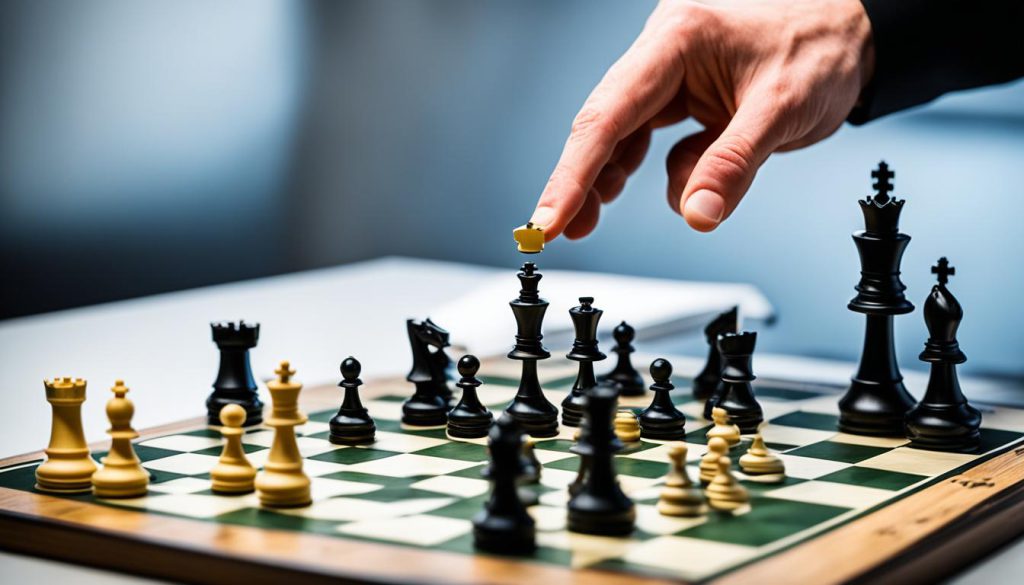
Testimonials
“When time is low, and I have to move fast, intuition and clear thinking have saved me. It’s about mixing calculation and instinct.” – Magnus Carlsen, World Chess Champion
Strategies for Accurate Play
- Stay calm and composed, even in challenging positions.
- Rely on your understanding of strategic principles to guide your decisions.
- Trust your intuition and make moves based on patterns and positional assessments.
- Practice analyzing complex positions and evaluating potential consequences.
- Learn from past experiences and use them as a guide for accurate decision-making.
Prompt and Accurate Decision-Making
In chess, when you can’t calculate, making quick and accurate decisions is critical. Players must trust their instincts and assess the position well. Despite the risks, honing intuition allows for effective play in tricky situations.
| Advantages of Accurate Play | Disadvantages of Inaccurate Play |
|---|---|
|
|
Judging the Tactical Compensation of Sacrifices
Chess tactics often involve sacrifices to create surprises and change the game’s direction. Not all sacrifices are equal, though. They vary in their immediate benefits or need careful evaluation to see their worth. Judging these moves needs calculation, intuition, and foresight.
In evaluating a sacrifice, consider what gains it might bring. Does it lead to a strong attack, make powerful passed pawns, or remove vital opponent defenses? We must look at the whole position and its possible future to evaluate a sacrifice right.
To judge the value of a sacrifice, calculation is key. By reviewing different moves, we can see the good and bad outcomes of a sacrifice. Yet, calculation isn’t everything. Intuition also helps us see hidden opportunities and the sacrifice’s long-term effects.
Intuition lets us spot patterns, judge position imbalances, and decide based on the position’s depth. It helps find the right times for sacrifices. With intuition, we balance risks and rewards and make smart choices.
“A sacrifice is best refuted by accepting it.” – Wilhelm Steinitz
To wrap it up, judging sacrifices in chess needs both calculation and intuition. By looking at the potential ups and downs, studying moves, and following our gut, we make choices that can lead to winning. Mastering this skill is crucial for advanced chess, letting players handle complex positions and take the lead.
Example:
| Sacrifice | Tactical Compensation | Positional Considerations |
|---|---|---|
| Queen sacrifice | Material advantage, devastating attack | Open lines, weak king position |
| Bishop sacrifice | Initiative, positional advantages | Restrict opponent’s pieces, control key squares |
| Pawn sacrifice | Development, central control | Open lines, potential for attacking play |
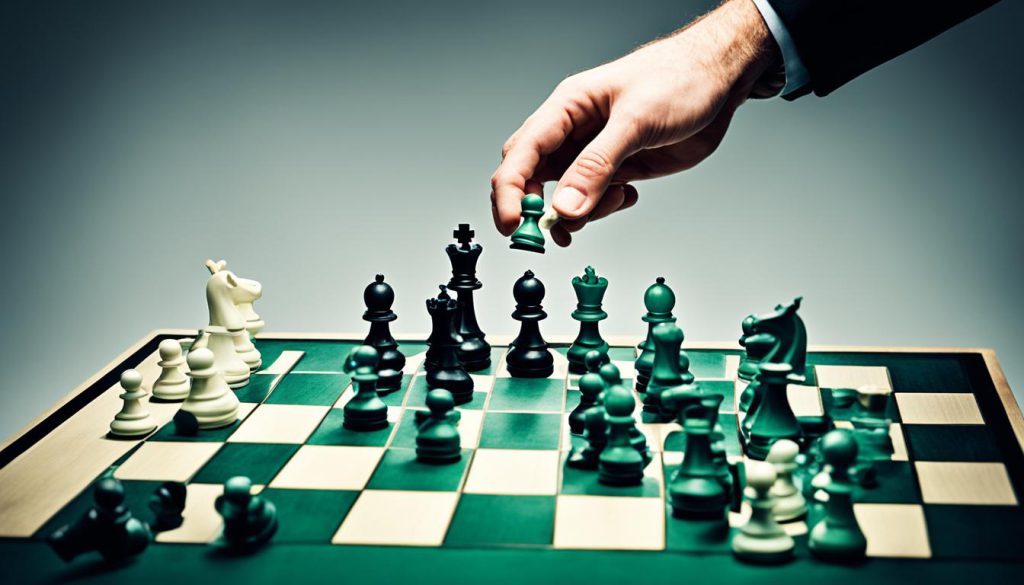
Advanced Tactics Training with GM Vidit Gujrathi
Improving your chess tactics requires advanced training. Grandmaster Vidit Gujrathi is your guide. In his video course, he explores advanced tactics, using real-life examples. This offers players a chance to learn from a top GM. They’ll see when to calculate and when to trust their gut.
Vidit’s course focuses on advanced tactics. This helps players understand complex positions and make quick, accurate moves. They learn to analyze checkmates and tactical combinations. The course gives a deep dive into high-level chess tactics.
The training also highlights the role of intuition in chess. Intuitive thinking is key during fast-paced games. Vidit teaches how to balance gut feelings and careful thought. Players learn to trust their instincts while staying precise.
Vidit uses various methods to teach his students. He provides clear explanations and hands-on exercises. This ensures players grasp advanced tactics. They learn how to apply these tactics in their own games.
“The key to advanced tactics is not solely relying on calculation but also knowing when to trust your intuition. This delicate balance is what separates the average players from the masters.” – Grandmaster Vidit Gujrathi
This image shows a crucial moment where tactics and calculations are key. By thinking ahead and evaluating moves, players can discover winning strategies. They learn to make decisions that can turn the game in their favor.
Example Scenario: Advanced Calculation and Tactics
Let’s look at a scenario from Vidit’s course.
| a | b | c | d | e | f | g | h | |
|---|---|---|---|---|---|---|---|---|
| 8 | ||||||||
| 7 | ||||||||
| 6 | ||||||||
| 5 | *K | |||||||
| 4 | *N | *Q | ||||||
| 3 | *B | |||||||
| 2 | ||||||||
| 1 |
*K: King; *N: Knight; *Q: Queen; *B: Bishop
In this spot, it’s Black’s turn. Try to find a tactical move that gives an edge. Think about different moves, sense the right one, and work out the effects. This sharpens your decision-making skills.
Vidit’s advanced tactics training boosts your ability to handle complex chess scenarios. It helps players spot winning moves that aren’t obvious. With hard work, players can improve their tactics and overall chess play.
Complete Tactics Manual for Advanced Players with IM Boroljub Zlatanovic
I’m thrilled to share IM Boroljub Zlatanovic’s Complete Tactics Manual. It’s perfect for advanced chess players. This guide aims to upscale your tactical skills. You’ll move beyond basic tactics and dive into complex themes and combinations.
IM Boroljub Zlatanovic is a chess master who has divided the book into 11 engaging chapters. Each one features real-game situations. They let you deep dive into advanced tactics and learn how to calculate moves carefully.
The manual stands out because it’s practical and applicable. IM Boroljub Zlatanovic makes complex ideas simple. This way, you can use them in your games.
“The Complete Tactics Manual for Advanced Players provides a challenging yet rewarding experience for players who are ready to elevate their tactical mastery.”
You will learn a lot about different tactical scenarios in this manual. For example, it covers tactical sacrifices and positional plays. With this knowledge, you can defeat your opponents and win more games.
But theory isn’t everything. The manual emphasizes learning by doing. You’ll work on exercises and analyze solutions. This helps improve your skill in spotting opportunities during your matches.
Let’s take a sneak peek at the chapters inside the Complete Tactics Manual:
Chapter 1: Discovered Attacks
- Here, you learn the strength of discovered attacks and their effective use
- You’ll see real-game examples that show how powerful these attacks can be
Chapter 2: Double Attacks
- It teaches the importance of double attacks in tactical combinations
- The chapter reviews games that display the force of double attacks
Chapter 3: Sacrifices
- You’ll understand how to evaluate and capitalize on sacrifices
- It explores different positions to apply sacrificial strategies
Chapter 4: Pins and Skewers
- Learn to use pins and skewers to win materials and get ahead
- Famous games help illustrate the effectiveness of these tactics
Chapter 5: Zwischenzug
- The manual explains the significance of intermediate moves
- You’ll study examples where these moves change the game
Chapter 6: X-Ray Attack
- This chapter helps you grasp and use X-ray attacks
- Analysis of games shows how these attacks lead to wins
Chapter 7: Desperado
- It shows how desperado moves can disrupt an opponent’s strategy
- You learn when sacrificing material offers a greater advantage
Chapter 8: Clearance Sacrifice
- Understand clearance sacrifices and how they set up major tactics
- It reviews games where these moves were decisive
Chapter 9: Overloading
- Learn to create opportunities by overloading an opponent’s piece
- It examines positions that demonstrate overloading’s impact on games
Chapter 10: Decoy
- Decoying is powerful for luring opponents into traps
- The chapter shows examples where decoys bring victory
Chapter 11: Trapped Pieces
- Learn how to trap an opponent’s piece effectively
- It discusses game situations where trapping was key to winning
IM Boroljub Zlatanovic’s manual will help you master complex tactics. Advanced players will find it incredibly useful. It prepares you to win by understanding deeper strategies.
Are you eager to improve your tactical gameplay? Get IM Boroljub Zlatanovic’s Complete Tactics Manual. Start your journey to becoming a tactical genius in chess right away!
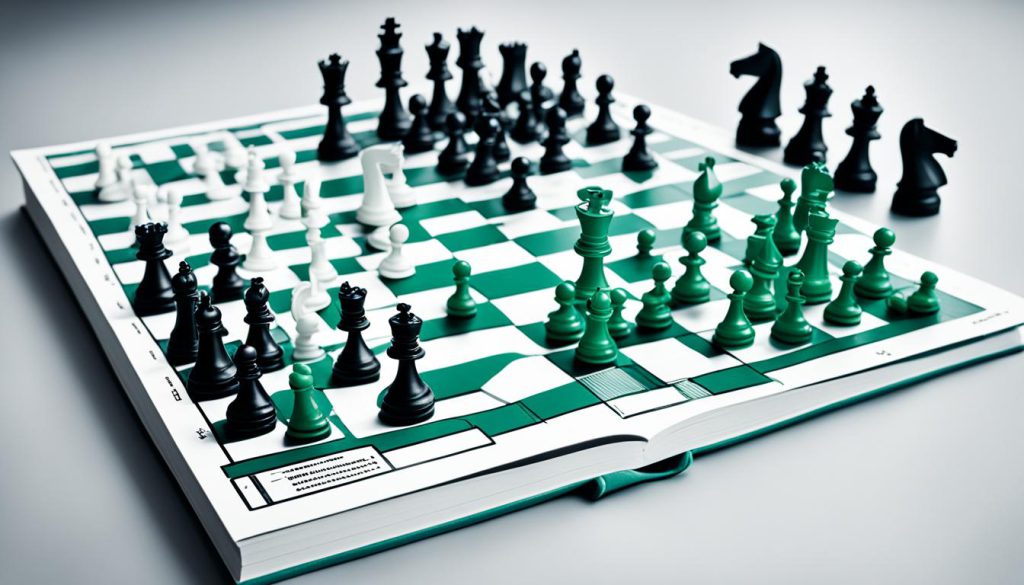
Tactical Training with ChessBase Apps
ChessBase apps are great for boosting your tactical skills. They give you a direct way to work on your game tactics. You get to tackle various key positions, which helps test and improve your strategic thinking.
Playing against Fritz, an advanced chess engine, is a key benefit of these apps. It lets you polish your tactics and understand better choices in games. They’re suited for all players, offering different levels of challenge to match your skill.
With ChessBase apps, you get solutions that explain each puzzle step-by-step. This feedback helps you understand the reasoning behind moves. You can learn from seasoned players and upgrade your tactical game.
Hands-On Tactical Training with ChessBase Apps
ChessBase apps let you learn by doing, which is more effective than just studying theory. You solve puzzles and make moves in real-time. This active learning makes it fun and boosts your tactical thinking.
“ChessBase apps have revolutionized my training regimen. The ability to solve puzzles and play against Fritz has taken my tactical understanding to new heights. I highly recommend these apps to any chess player looking to improve their gameplay.”
Adding ChessBase apps to your practice can seriously up your game. They’re easy and fun to use, wherever you are. No matter your level, these apps have what you need to boost your tactics.
The Importance of Advanced Tactics for Chess Improvement
Advanced tactics are key in getting better at chess. Beginners start with the basics. But, advanced players work on foreseeing many moves ahead. They learn to make smart choices quickly.
Training in advanced tactics deepens your chess skills. It makes you better at figuring out complicated game situations. This step is crucial for mastering chess.
Combining Tactics and Strategy in Chess
Chess is a game that mixes quick moves and long-term plans. Tactics are about making smart moves quickly to take the lead. Strategy, on the other hand, is about planning ahead and arranging pieces. As I got better at chess, I learned to blend these two for a winning approach.
I use tactics and strategy together to spot and use opportunities. With tactics, I find and make strong moves that give me an edge right away. These moves, like a surprise checkmate or grabbing extra pieces, are key to my game.
But, having a good plan is just as important. I focus on where to place my pieces, how to set up my pawns, and take control of important areas. This helps me think ahead and make moves that will help me win later on.
Tactics and strategy work together. They help me make a solid plan that increases my chance of winning.
Dealing with tough situations in chess, I use both tactics and strategy. I look at the game closely to spot tactical chances. At the same time, I think about the overall game, checking both my and my opponent’s strengths and weaknesses.
This mix helps me make smarter choices in the game. I can adjust my plan as the game changes, keeping my strategy while catching tactical chances. This flexibility helps me stay one step ahead.
Implementing Tactics and Strategy: A Practical Example
Let’s see how tactics and strategy work together in a real chess move:
- Starting with a bold move, sacrificing a knight to open up the king.
- Accepting the sacrifice, but now facing a bigger threat.
- Planning ahead, positioning the bishop to attack the weak king.
- Black tries to defend, but it prepares for the final hit.
- Ending with a tactical strike, the queen checkmates.
In this game, the knight sacrifice (1) opens the board for an attack. Placing the bishop on g6 (2) prepares for the next move. And then, the queen delivers a checkmate (3), winning the game.
Using tactics and strategy together leads to a strong play style. It’s crucial for winning, whether by smart moves or by following a thorough plan.
Enhancing Chess Calculation Skills
As an advanced player, improving chess calculation skills is key. It lets me picture the board and think ahead. This helps with better choices and strategy. To get better, I practice calculation exercises and solve tough puzzles. This improves my abilities and my tactical sense. Training regularly and tackling various tactical problems sharp my thinking and boost my chess play.
Visualization is essential for better chess calculation. By imagining board positions and moves, I understand the tactics better. I can also guess my opponent’s moves. This is very helpful in tricky situations where you need to be precise.
“Visualization is the cornerstone of accurate calculation in chess. The ability to see the board in your mind’s eye allows you to calculate variations more effectively and evaluate different possibilities with greater clarity.” – Grandmaster Anish Giri
Another way to improve is by doing chess puzzles. They need exact calculation and good choices. These puzzles make me analyze better and stay focused during the game.
Benefits of Enhancing Chess Calculation Skills:
- Increased accuracy in predicting opponent’s moves
- Better strategic planning and decision-making
- Improved ability to calculate long sequences of moves
- Enhanced tactical intuition and pattern recognition
To see how I’m doing, I keep track of my practices and puzzles. Reviewing my errors teaches me a lot. This way, I fine-tune my skills and become tougher to beat.
| Chess Calculation Exercise | Result |
|---|---|
| Evaluating a complex middlegame position | Correct – identified winning combination |
| Calculating a tactical sequence in the endgame | Incorrect – missed a crucial move |
| Visualizing a potential queen sacrifice | Correct – found a winning continuation |
By practicing consistently and focusing on visualization, I improve my chess calculation. Combining precise calculation, strategic planning, and intuitive decisions, I’m getting better at chess.
Further Reading:
- Common Mistakes in Chess Visualization
- The Importance of Visualization in Chess
- The Role of Intuition in Chess Calculation
Conclusion
Learning advanced chess tactics is key for anyone aiming to improve their game. It’s about understanding combinations, making smart moves, and knowing when to sacrifice. These skills boost both your tactical play and strategy.
To get better at chess, use online resources. Look for courses on advanced chess tactics. They teach important skills and tricks to enhance your gameplay.
Books by skilled players can also help. They give in-depth advice on complex tactics. This lets you learn new strategies and improve your game.
Online platforms and apps for chess tactics are useful too. They let you solve puzzles and play against tough computer opponents. This practice sharpens your tactical thinking and decision-making.
But remember, getting better at chess takes hard work and constant practice. Keep training in advanced tactics. Then you’ll be able to outsmart your opponents and win more games.
